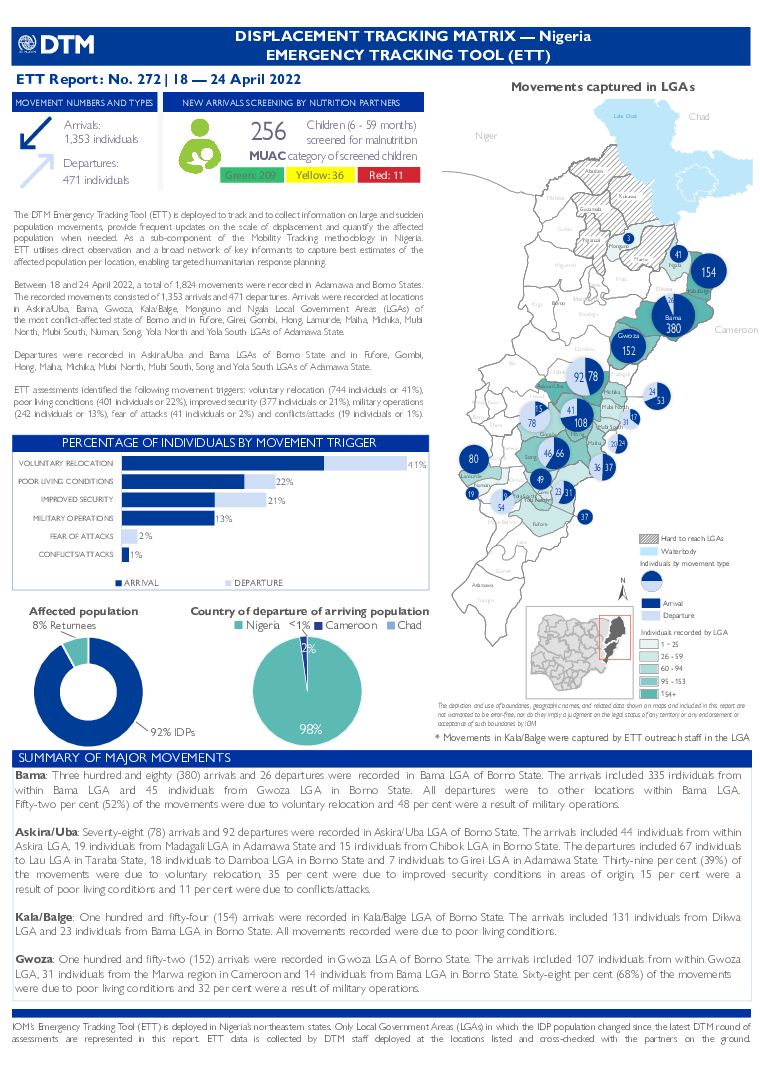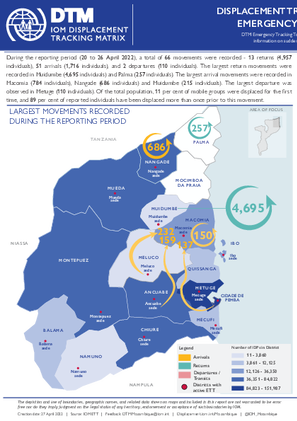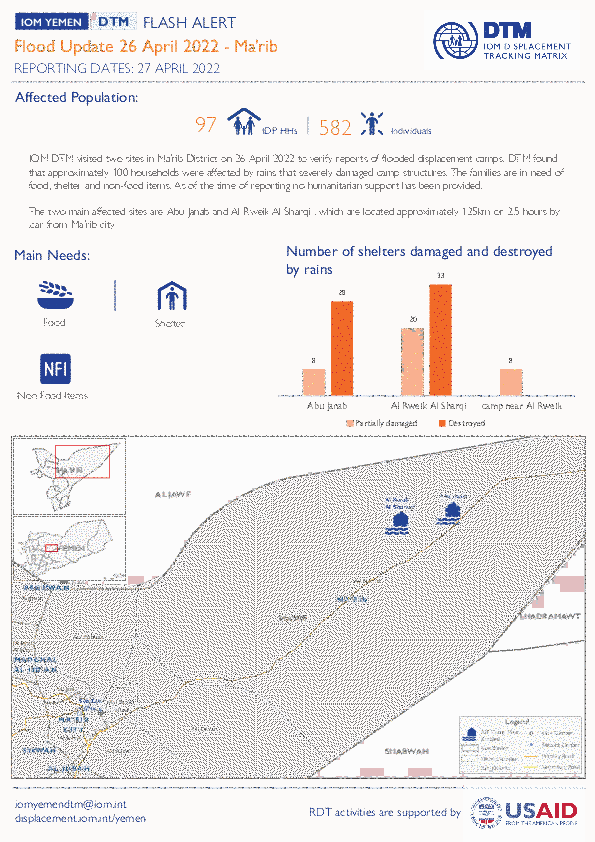-
Countries
-
Data and Analysis
-
Special Focus
-
Crisis Responses
Contact
DTM Mozambique, DTMMozambique@iom.int
Location
Mozambique
Activity
- Mobility Tracking
- Site Assessment
Period Covered
Jan 10 2022 -Feb 15 2022
A site assessment is a sub-component of mobility tracking. It aims to collect data on population presence, living conditions and needs in a particular displacement site or community.
Population Groups
Survey Methodology
Unit of Analysis Or Observation
Type of Survey or Assessment
Keywords
Geographical Scope
Administrative boundaries with available data
The current dataset covers the following administrative boundaries

Contact
jali@iom.int
Language
English
Location
Trinidad & Tobago
Period Covered
Dec 01 2021
Dec 31 2021
Activity
- Survey
- Flow Monitoring Survey
The Borough of Chaguanas is the largest municipality and fastest-growing town in Trinidad and Tobago. It is situated on the western coast of Trinidad, upstream from the Caroni Swamp, between the two main cities of Port of Spain and San Fernando.1 Chaguanas spans 59km², with a population of 83,516 persons.2 It comprises several communities and sub-areas, which encompass vast areas of agricultural land. Moreover, this region’s human development index, in 2012, was 0.686 and 62.9% of its population had obtained secondary and higher education.3 Accordingly, given the trend of escalating inflows of Venezuelan nationals into Trinidad and Tobago,4 Chaguanas has featured in Displacement Tracking Matrix (DTM) 2021 as having the second highest number of Venezuelan migrant respondents in the exercise. Furthermore, in the wake of the Covid-19 pandemic, heightened health and safety protocols to combat the spread of the virus, have inadvertently exacerbated economic issues and migrant vulnerabilities. Notwithstanding this, in March 2021, the Government of Trinidad and Tobago (GORTT) conducted a re-registration exercise for Venezuelans, who were previously registered under the Venezuelan Migrant Registration Framework in June 2019, to extend their regular status and options for legitimate employment. In addition, with the assistance of the Venezuelan Embassy, there was a major voluntary repatriation exercise of 680 Venezuelan nationals, in July 2021. Apart from this, COVID-19 vaccines have been made available to Venezuelan migrants in Trinidad and Tobago. The DTM 2021, Sub-report for the Borough of Chaguanas, therefore presented an excellent opportunity to examine the situation of Venezuelan migrants against these backgrounds, and within the framework of the Fostering local communities of solidarity for migrants and refugees project, which is funded under the Development Cooperation Instrument (DEVCO). IOM’s DTM is a system to track and monitor displacement and population mobility. It is designed to capture, process, and disseminate critical multi-layered information on the mobility, vulnerabilities, and needs of displaced and mobile populations, regularly and systematically. Hence, the DTM provides decision-makers and responders with insightful data to guide specific assistance to target populations. A total of 188 Venezuelan migrants from the Borough of Chaguanas participated in DTM 2021 between October and November 2021. The areas with the highest number of respondents were Cunupia, followed by Longdenville, and Chaguanas Proper, as shown in Map 1. It must be noted, however, that 18 respondents indicated that they did not know in which community they resided.

Contact
DTM Nigeria, AllUsersInDTMNigeria@iom.int
Language
English
Location
Nigeria
Period Covered
Apr 18 2022
Apr 24 2022
Activity
- Mobility Tracking
- Event Tracking
The DTM Emergency Tracking Tool (ETT) is deployed to track and to collect information on large and sudden population movements, provide frequent updates on the scale of displacement and quantify the affected population when needed. As a sub-component of the Mobility Tracking methodology in Nigeria.
ETT utilises direct observation and a broad network of key informants to capture best estimates of the affected population per location, enabling targeted humanitarian response planning.
Between 18 and 24 April 2022, a total of 1,824 movements were recorded in Adamawa and Borno States. The recorded movements consisted of 1,353 arrivals and 471 departures. Arrivals were recorded at locations in Askira/Uba, Bama, Gwoza, Kala/Balge, Monguno and Ngala Local Government Areas (LGAs) of the most conflict-affected state of Borno and in Fufore, Girei, Gombi, Hong, Lamurde, Maiha, Michika, Mubi North, Mubi South, Numan, Song, Yola North and Yola South LGAs of Adamawa State.
Departures were recorded in Askira/Uba and Bama LGAs of Borno State and in Fufore, Gombi, Hong, Maiha, Michika, Mubi North, Mubi South, Song and Yola South LGAs of Adamawa State.
ETT assessments identified the following movement triggers: voluntary relocation (744 individuals or 41%), poor living conditions (401 individuals or 22%), improved security (377 individuals or 21%), military operations (242 individuals or 13%), fear of attacks (41 individuals or 2%) and conflicts/attacks (19 individuals or 1%).

Contact
DTMMozambique@iom.int
Language
English
Location
Mozambique
Period Covered
Apr 20 2022
Apr 26 2022
Activity
- Mobility Tracking
- Event Tracking
During the reporting period (20 to 26 April 2022), a total of 66 movements were recorded - 13 returns (4,957 individuals), 51 arrivals (1,716 individuals), and 2 departures (110 individuals). The largest return movements were recorded in Muidumbe (4,695 individuals) and Palma (257 individuals). The largest arrival movements were recorded in Macomia (784 individuals), Nangade (686 individuals) and Muidumbe (215 individuals). The largest departure was observed in Metuge (110 individuals). Of the total population, 11 per cent of mobile groups were displaced for the first time, and 89 per cent of reported individuals have been displaced more than once prior to this movement.

Contact
DTM Mozambique, DTMMozambique@iom.int
Language
English
Location
Mozambique
Period Covered
Apr 06 2022
Apr 19 2022
Activity
- Other
- Mobility Tracking
From 6 to 19 of April DTM teams in Muidumbe district have recorded a significant number of individuals returning to their places of origin. An estimated 8,697 individuals have returned in the localities of Mapate, Muambula, Muatide and Namacande. Reported returnees are moving spontaneously by bus. Reports indicate that all assessed individuals were displaced more than once prior to present return movement.

Contact
DTM Guinée, oimguineedtm@iom.int
Language
French
Location
Guinea
Period Covered
Feb 01 2022
Feb 28 2022
Activity
- Survey
- Flow Monitoring
- Migrants presence
Pour mieux comprendre cette dynamique, une mis-sion de collecte des données a été conduite conjointe-ment par l’Organisation In ternationale pour les Migrations (OIM) et l’Institut Na tional de la Statistique (INS) et s’in-scrit dans le cadre du partenariat entre les deux institu-tions pour la collecte et le partage des données migratoires. L’étude a pour but de mieux comprendre la dynamique migratoire dans le contexte de la migration irrégulière dans les zones à fort taux de départ et de transit dans la préfecture de Siguiri (Siguiri-Centre, Kourémalé et Doko).

Contact
DTM Cameroon, DTMCameroun@iom.int
Language
French
Location
Cameroon
Period Covered
Apr 21 2022
Apr 26 2022
Activity
- Event Tracking
- Mobility Tracking
L’objectif de l’outil de suivi des urgences est de rassembler des informations sur les mouvements significatifs et soudains de populations. Ce tableau de bord présente des informations sur des mouvements de personnes survenus entre le 21 et le 25 avril et les mouvements de retour portée à notre attention pendant la même période dans le département de Mayo Tsanaga et Mayo Sava (région de l’Extrême-Nord).

Contact
DTM Cameroon, DTMCameroon@iom.int
Language
French
Location
Cameroon
Period Covered
Feb 09 2022
Feb 17 2022
Activity
- Mobility Tracking
- Baseline Assessment
Ce dashboard donne un aperçu de la situation dans la région de l’Extrême-Nord du Cameroun, où l’insécurité liée aux violences de groupes extrémistes armés et, dans une moindre mesure, les phénomènes climatiques et les pluies saisonnières, ont donné lieu à d’importants mouvements de population. Les informations présentées dans ce dashboard ont été recueillies auprès des personnes déplacées avec l’accord et le soutien des autorités locales, entre le 9 et le 17 février 2022. Au round 24 de la DTM, un total estimatif de plus de 558 000 individus a été identifié, dont 378 000 PDI, 50 000 réfugiés hors camp et 131 000 retournés. Le nombre de PDI a augmenté de 6 pour cent, le nombre de réfugiés hors camp a baissé de 5 pour cent et le nombre de retournés a baissé de 3 pour cent depuis le dernier round.

Contact
DTM Cameroun, DTMCameroon@iom.int
Language
French
Location
Cameroon
Period Covered
Feb 09 2022
Feb 17 2022
Activity
- Mobility Tracking
- Baseline Assessment
En août 2021 l’Arrondissement du Logone-Birni, du département du Logone et Chari, région de l’Extrême-Nord du Cameroun, a connu des affrontements communautaires. Ces affrontements ont causé des déplacements de milliers de personnes. Alors qu’une accalmie s’instalait et qu’une proportion des populations déplacées étaient retournées dans leur localité d’origine, un nouveau conflit intercommunautaire lié à l’accès et au contrôle des ressources naturelles a éclaté le 5 décembre 2021, conduisant à la destruction de plus d’une quarantaine de villages et à de nouveaux déplacements de populations. Les affrontements issus de la crise dans le Logone-Birni ont contraint les populations au déplacement dans le reste du département du Logone et Chari et dans les départements du Mayo-Danay, du Mayo-Sava et du Diamaré.
Ce rapport, annexé au document complet du Rapport sur les déplacements Round 24 de l'OIM Cameroun, présente des analyses spécifiques aux déplacements des populations dus aux conflits intercommunautaires ayant eu lieu dans l’arrondissement du Logone Birni. Les analyses sont effectuées sur la base des données récoltées par la Matrice de suivi des déplacements (DTM) entre le 9 et le 17 février 2022.

Contact
DTM Yemen, iomyemendtm@iom.int
Language
English
Location
Yemen
Period Covered
Apr 25 2022
Apr 26 2022
Activity
- Rapid Emergency Registration
- Mobility Tracking
IOM DTM visited two sites in Ma’rib District on 26 April 2022 to verify reports of flooded displacement camps. DTM found
that approximately 100 households were affected by rains that severely damaged camp structures. The families are in need of
food, shelter and non-food items. As of the time of reporting no humanitarian support has been provided.
The two main affected sites are Abu Janab and Al Rweik Al Sharqi , which are located approximately 125km or 2.5 hours by
car from Ma’rib city.
